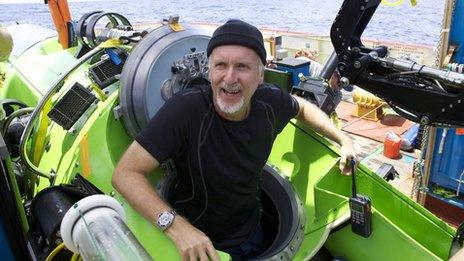New record for deepest fish
- Published
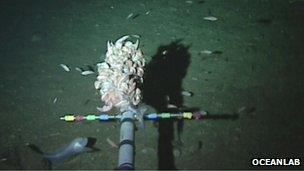
The fish moves in from the bottom-left of the image towards the baited lander
A new record has been set for the world's deepest fish.
The bizarre-looking creature, which is new to science, was filmed 8,145m beneath the waves, beating the previous depth record by nearly 500m.
Several other new species of fish were also caught on camera, as well as huge crustaceans called supergiants.
The animals were discovered during an international expedition to the Mariana Trench, which lies almost 11km down in the Pacific Ocean.
The 30-day voyage took place from the Schmidt Ocean Institute's research vessel, Falkor, and is the most comprehensive survey of world's deepest place ever undertaken.
The Hadal Ecosystem Studies (Hades) team deployed unmanned landers more than 90 times to depths that ranged between 5,000m and 10,600m. They studied both steep walls of the undersea canyon.
Dr Jeff Drazen, co-chief scientist from the University of Hawaii, US, said: "Many studies have rushed to the bottom of the trench, but from an ecological view that is very limiting.
"It's like trying to understand a mountain ecosystem by only looking at its summit."
The University of Aberdeen's Hadal Lander - the UK's deepest diving vehicle - recorded more than 100 hours of deep-sea footage.
Until this expedition, the deepest fish had been found in the Japan Trench, also in the Pacific Ocean. A 17-strong shoal of pink, gelatinous snailfish (Pseudoliparis amblystomopsis) were recorded 7,700m down.
Dr Alan Jamieson, from Oceanlab at the University of Aberdeen, said: "After we found these, we started seeing them in other deep trenches. Each trench has its own snailfish species.
"And we saw one in the Mariana Trench at more than 8,000m, and we think it's a new species."
The team thought they had broken the deepest-fish record, but then another pale pink species came to feed at the lander, which is loaded with bait, even further down at 8,145m.
Fish are filmed more than 8km down in the Mariana Trench
Dr Jamieson said: "We think it is a snailfish, but it's so weird-looking; it's up in the air in terms of what it is.
"It is unbelievably fragile, and when it swims, it looks like it has wet tissue paper floating behind it.
"And it has a weird snout - it looks like a cartoon dog snout."
Without catching the fish and bringing it back to the surface, the team is unable to confirm that it is a new species, but Dr Jamieson said it did not look like anything he'd seen before or knew of.
The new record-breaking creature is close to the depth-limit at which scientists believe fish can survive.
They researchers also captured another bizarre species - supergiants - on camera.
These creatures are a type of amphipod, which are normally around 2-3cm long. The super-sized version can reach up to 30cm.
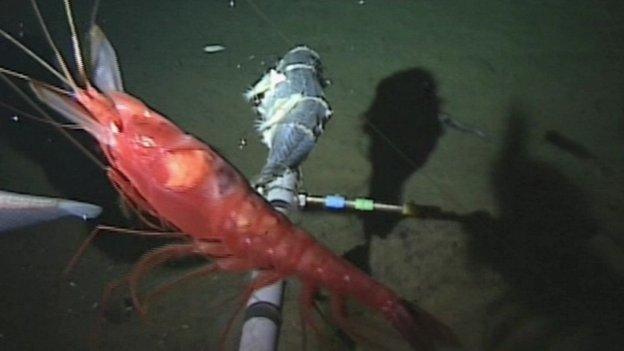
Decapod shrimp are among the other residents of the deep ocean
Dr Jamieson said: "We've got more than 20 hours of footage of them, and we're learning the way they swim, the way they feed and the way they fend off predators.
"They clamp down on the bait, and bore their head into it and put their spiky tail in the air like a thorn bush.
"Anything that goes for it gets stabbed in the nose."
Plate suggestion
During the voyage, researchers also studied the geology of the Mariana Trench by grabbing rocks and returning them to the surface.
Prof Patricia Fryer, from the University of Hawaii, told the American Geophysical Union Fall Meeting in San Francisco that a sample collected from an earlier expedition suggested that a previously undiscovered tectonic plate lies at the bottom of the trench.
"The rock we picked up - it turns out this thing is 100 million years younger than the Pacific Plate," she told BBC News.
"It means that the plate that's being subducted beneath the Challenger Deep (the lowest point of the trench) is 100 million years or more younger than the Pacific Plate."
At the plate boundary, the scientists also found rocks that suggested volcanic activity at a depth of 5,000m - the deepest underwater eruption known.
"The amazing thing about these little rocks is that they are all covered with volcanic glass," Prof Fryer explained.
"The only way they form is if this volcanic magma is instantly cooled when it left the vent - material coming out hit the sea water and instantaneously froze.
"Most volcanologists would say that you can't get explosive volcanism much deeper than a couple of km - but we found these rocks 5,000m down."
She added: "So much of the ocean floor is unexplored; every time we go down we find something new."
Distant place
The dives made during the expedition were all conducted by unmanned vehicles, but humans have visited the world's deepest place.
In 1960, US Navy Lt Don Walsh and Swiss oceanographer Jacques Piccard made an incredibly risky journey to the bottom of the Mariana Trench in a bathyscaphe called the Trieste.
And in 2012, Hollywood director James Cameron made a solo descent to the seafloor in his sub called the Deepsea Challenger.
He described the place as a desolate, alien world.
Follow Rebecca on Twitter., external
- Published4 March 2014
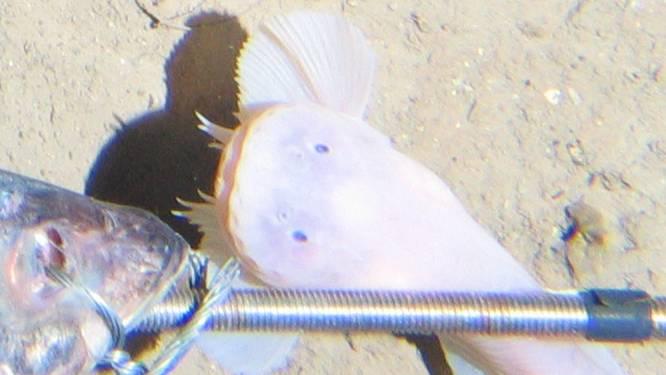
- Published2 February 2012
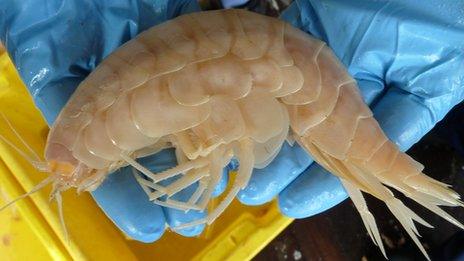
- Published26 March 2012
